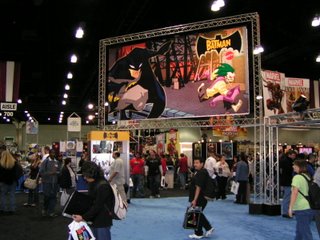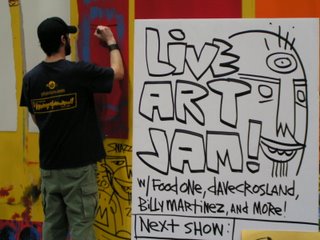Wizard World Los Angeles 2006
 Wizard World Los Angeles is a large annual comic book convention with a focus on superhero titles. It's but one facet of the Wizard universe spanning multiple magazines, a website, and conventions across the country each year. This is only the third year for the LA show, and the first one actually held in LA following initial outings at the Long Beach Convention Center.
Wizard World Los Angeles is a large annual comic book convention with a focus on superhero titles. It's but one facet of the Wizard universe spanning multiple magazines, a website, and conventions across the country each year. This is only the third year for the LA show, and the first one actually held in LA following initial outings at the Long Beach Convention Center.The move to the LA Convention Center gives the show plenty of room to grow, which was plainly evident by the booths that didn't quite stretch to the limits of the single hall hosting this year's event. Wizard World's biggest event is its annual Chicago summer show, and for anyone who has attended that one, the LA event space appeared to be roughly half its size.
Wizard has a tough market in Southern California competing with San Diego's Comic Con International, the world's largest, but its new location makes it ideal for ease of access by entertainment industry guests. The only problem is that Hollywood hasn't really caught on to its existence yet, so the caliber of guests thus far has leaned decidedly toward B-list status or less. On the upside for comic fans, the lack of Hollywood attention makes this much more of a true comic book convention that the mass media spectacle of San Diego.
 The show ran for three days this year, with the biggest concentration of special guests and visitors on Saturday. I hit the floor after noon on Saturday and immediately noticed how much easier it was to move around compared to the hysteria of San Diego. I'm not suggesting that the show was dead, but it definitely wasn't overcrowded.
The show ran for three days this year, with the biggest concentration of special guests and visitors on Saturday. I hit the floor after noon on Saturday and immediately noticed how much easier it was to move around compared to the hysteria of San Diego. I'm not suggesting that the show was dead, but it definitely wasn't overcrowded.The media company booths were all aligned by the front doors, so visitors were funneled past the big players first and gradually moved back through smaller publishers to the retailers in the back section of booths. Yes, there were actual dealers selling real live comic books at the show, not a ton of them, but enough that visitors could easily shop for classic golden and silver age comics or the latest releases, as well as graphic novels, manga, toys, dvds, and apparel. Past the retailers was a lonely assortment of gaming tables and an artists alley with a few top artists such as Tim Sale and David Mack tucked in between the up and comers.
 Comic book artist Jim Mahfood and friends were painting art live at the Golden Apple booth, a stunt that proved to be a hit with the attendees passing by.
Comic book artist Jim Mahfood and friends were painting art live at the Golden Apple booth, a stunt that proved to be a hit with the attendees passing by.The pieces were all for sale after completion.
While the celebrity quotient was fairly small, the collection of comic book creators was strong, with many key players from the big houses of Marvel and DC on hand to sign autographs and offer previews of this year's coming attractions. The biggest draw was probably DC's Jim Lee due to his blast back to the top of the artist popularity charts with key runs on both Batman and Superman over the past few years. Former Image mate Marc Silvestri was on hand to preview the upcoming releases from his Top Cow studio, while Silvestri's former protege Michael Turner was also onhand with all the latest exclusives from his Aspen studio. Image co-founder Rob Liefeld (creator of their iconic "i" logo, but no longer a part of the label) was also spotted on the fringes with his Arcade comic releases.
 As for celebrities, Charisma Carpenter from Buffy and Angel appeared to sign autographs, but 2006 is apparently the year where Buffyverse fandom has finally hit a wall since her booth was a ghost town, causing her to leave within about 20 minutes. A few other players from Angel were appearing in another booth, but didn't look to be faring much better.
As for celebrities, Charisma Carpenter from Buffy and Angel appeared to sign autographs, but 2006 is apparently the year where Buffyverse fandom has finally hit a wall since her booth was a ghost town, causing her to leave within about 20 minutes. A few other players from Angel were appearing in another booth, but didn't look to be faring much better.Lou Ferigno was on hand to prove again that he's the Dick Clark of superhero actors, still looking exactly the same as his Incredible Hulk days.
Jack O'Halloran from Superman 1 and 2 made a rare appearance, and Margot Kidder was also scheduled to appear.
The Wayans Brothers were on hand to discuss a new comic book they're producing.
Comedian Brian Posehn was pimping a new comic book he's writing, and seemed somewhat uncomfortable to be on the signing side of the table rather than circulating with the rest of the fans as he usually does in San Diego.
The big media star of the day was undoubtedly Kevin Smith, the one celebrity who unquestionably belongs at a comic book convention due to his longstanding comic book fandom, writing, and store ownership. He held court in the show's largest meeting hall for two hours during which he took questions from the audience and made his responses in turn hilarious, endearing, informative, and dirty. Jason Mewes popped in for a minute but left the proceedings to Smith as usual, cueing Smith to note that their real life roles are the polar opposite of their film roles as Jay and Silent Bob.
 The audience questions were fairly stupid at first, but eventually somebody got around to asking about his latest acting roles, which allowed him to talk about his involvement in both Richard Kelly's follow up to Donnie Darko called Southland Tales, as well as his role as the "fat friend" in an upcoming Jennifer Garner romantic comedy. He particularly relished recounting his experience on the latter film as he apparently had an acrimonious relationship with star Timothy Olyphant. Smith decided to improvise his lines because they didn't sound natural to him, and Olyphant wasn't a fan of the results or his acting in general, believing that nobody would appreciate Smith's contributions to the film. Fast forward a few months to a test screening Smith crashed where he had the pleasure of spying on the focus group. The group leader asked the viewers what they liked best about the film, and somebody said "Kevin Smith", to which the leader said that was interesting and asked if anybody else thought that...and all 20 people raised their hands. "Fuck you, Olyphant!" indeed. He also discussed his upcoming sequel to Clerks when prompted, but didn't dwell on the subject for long.
The audience questions were fairly stupid at first, but eventually somebody got around to asking about his latest acting roles, which allowed him to talk about his involvement in both Richard Kelly's follow up to Donnie Darko called Southland Tales, as well as his role as the "fat friend" in an upcoming Jennifer Garner romantic comedy. He particularly relished recounting his experience on the latter film as he apparently had an acrimonious relationship with star Timothy Olyphant. Smith decided to improvise his lines because they didn't sound natural to him, and Olyphant wasn't a fan of the results or his acting in general, believing that nobody would appreciate Smith's contributions to the film. Fast forward a few months to a test screening Smith crashed where he had the pleasure of spying on the focus group. The group leader asked the viewers what they liked best about the film, and somebody said "Kevin Smith", to which the leader said that was interesting and asked if anybody else thought that...and all 20 people raised their hands. "Fuck you, Olyphant!" indeed. He also discussed his upcoming sequel to Clerks when prompted, but didn't dwell on the subject for long. The Saturday show wrapped up around 6, and while it was far from a runaway success, it did show quite a bit of growth from last year's event. Attendance in future years would most likely benefit by a push for more presence by the niche corners of the industry such as small press and manga, more programming, as well as more Hollywood involvement to increase the must see factor. It would be great to see this event grow to fill the entire LA Convention Center someday, but for now it's a fun event for mainstream super hero fans.
The Saturday show wrapped up around 6, and while it was far from a runaway success, it did show quite a bit of growth from last year's event. Attendance in future years would most likely benefit by a push for more presence by the niche corners of the industry such as small press and manga, more programming, as well as more Hollywood involvement to increase the must see factor. It would be great to see this event grow to fill the entire LA Convention Center someday, but for now it's a fun event for mainstream super hero fans.






